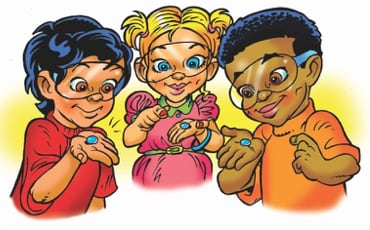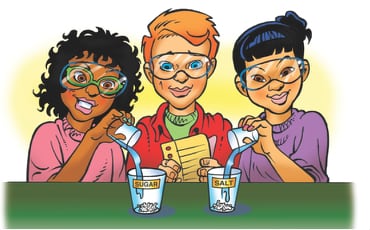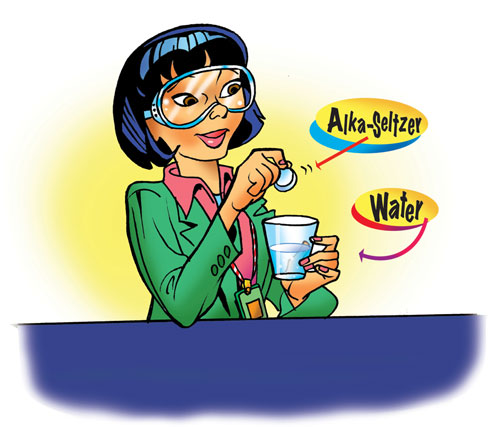Lesson Overview for Teachers
View the video below to see what you and your students will do in this lesson.
Objective
Students will be able to explain that mixing substances can cause a chemical reaction that results in the formation of a new substance. Students will be able to plan and carry out an investigation to compare the amount of bubbles produced by a solid “soap scum” precipitate with the bubbles produced from soap. Students will also be able to explain that different substances react in a characteristic way that can be used to identify a substance.
Key Concepts
- Mixing substances can result in a chemical reaction that produces new substances.
- Two liquids can chemically react to produce a solid.
- Substances have characteristic chemical reactions that can be used to identify a substance.
- Designing a fair test to study chemical reactions requires keeping everything the same except for the one thing you want to know about.
NGSS Alignment
- NGSS 5-PS1-3: Make observations and measurements to identify materials based on their properties.
- NGSS 5-PS1-4: Conduct an investigation to determine whether the mixing of two or more substances results in new substances.
Summary
- Students prepare a soap solution by dissolving Ivory soap in water.
- Students also make an Epsom salt solution to simulate hard water.
- Students combine the soap solution with the Epsom salt solution to produce a solid “soap scum” precipitate.
- Students then carry out a bubble test on the solid soap scum and Ivory soap to determine if they are different.
The two main ideas for students to understand from this activity are that mixing substances can result in the formation of a new substance, and that the way different substances react is a characteristic property that can be used to identify a substance.
Evaluation
Download the student activity sheet (PDF) and distribute one per student when specified in the activity. The activity sheet will serve as the Evaluate component of the 5-E lesson plan.
Safety
Make sure you and your students wear properly fitting safety goggles. Do not handle solid sodium carbonate with bare hands. Sodium carbonate may cause skin and serious eye irritation. Sodium carbonate, also called soda ash or washing soda, is available at many hardware stores and may also be purchased from various chemical suppliers, such as Carolina Biological Supply Company or Flinn Scientific. Follow all safety precautions regarding the use, storage, and disposal of sodium carbonate.
Clean-up and Disposal
Remind students to wash their hands after completing the activity. All common household or classroom materials can be saved or disposed of in the usual manner.
Materials
Materials for the demonstration
- 2 clear plastic cups
- Sodium carbonate
- Magnesium sulfate (Epsom salt)
- Water
- Graduated cylinder
- Teaspoon
- Knife (to cut soap)
Materials needed for each group
- Water
- Epsom salt
- 1 piece of Ivory soap
- Paper towel
- 2 Popsicle sticks
- 2 Empty 8-oz disposable water bottles with lids
- 4 Clear plastic cups
- 1 Small cup
- 1 Tablespoon
- 1 Teaspoon
Notes about the materials
One or two bars of soap is enough for an entire class to do this activity.
Teacher Preparation
- Label 1 small cup Epsom salt for each group.
- Place 2 teaspoons of Epsom salt in its labeled cup.
- Cut one or two bars of Ivory soap so that each group gets about 1/4 of a bar.
Engage
Do a demonstration to introduce the concept of a precipitate – formation of a solid from the reaction of two liquids.
Remind students that they have seen that mixing certain substances can result in a chemical reaction that produces a new substance. So far, students have observed a gas produced when certain solids and liquids are mixed. Tell students that sometimes when two liquids are mixed, a solid forms. This solid is a new substance, and it’s called a precipitate. Explain that when substances are mixed and a new substance is formed, a chemical reaction has occurred.
Demonstrate the production of a precipitate using magnesium sulfate (Epsom salt) and sodium carbonate. These same reactants will be used in Lesson 4.1 to study the conservation of mass.
Materials for the demonstration
- 2 Clear plastic cups
- Sodium carbonate
- Magnesium sulfate (Epsom salt)
- Water
- Graduated cylinder
- Teaspoon
- Popsicle sticks for stirring
SAFETY NOTES: Sodium carbonate may cause skin and serious eye irritation. Avoid contact of the solid with eyes and skin. Follow all safety precautions regarding the use, storage, and disposal of sodium carbonate.
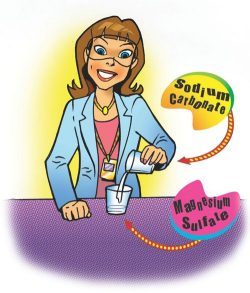
Procedure
- In a clear plastic cup add 50 mL of water and 1 teaspoon of Epsom salt. Swirl or stir until the Epsom salt dissolves.
- To another cup, add 50 mL of water and 1 teaspoon of sodium carbonate. Swirl or stir until the sodium carbonate dissolves.
- Hold the cups up so the students can see them. Slowly add the sodium carbonate solution to the Epsom salt solution.
Expected results:
White solid particles will form and deposit as a precipitate.
Tell students that a chemical reaction took place and that a solid was formed. When a solid forms from two solutions in this way, the solid is called a precipitate. A characteristic property of these solutions is that they form a precipitate when mixed. Tell students they will also make a precipitate called soap scum by mixing a soap solution with an Epsom salt solution.
Give each student an Activity Sheet (PDF).
Students will record their observations and answer questions about the activity on the activity sheet.
Explore
Question to investigate: What happens when soap is mixed with “hard” water?
Have students combine a soap solution with an Epsom salt solution to form a soap scum precipitate.
Materials needed for each group
- Water
- Epsom salt
- Piece of Ivory soap
- Paper towels
- 2 Popsicle sticks
- 2 Empty disposable water bottles (8-oz) with caps
- 4 Clear plastic cups
- 1 Small cup
- 1 Tablespoon
- 1 Teaspoon
- Sink or plastic bucket with water (to wash out and reuse the cups)
Explain that “soap scum” is a common example of a precipitate that forms when certain minerals in water react with soap molecules. Tell students that they are going to make “hard water” and see how it reacts with soap. Explain that hard water is water that contains dissolved minerals, such as calcium, iron, and magnesium. Tell students that they will add soap to hard water to create soap scum. Then they will compare the bubbling ability of soap and soap scum to find out whether soap scum is a new substance or the same as soap.
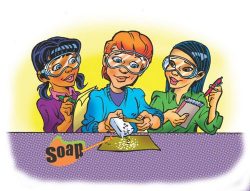
Procedure
- Label three plastic cups Soap, Water, and Hard Water.
- Hold a piece of Ivory soap on a piece of paper. Use a popsicle stick or plastic spoon to scrape soap flakes onto the paper.
Making the soap solution
- To make a soap solution, place ¼ cup of water in the Soap cup and add about 1 tablespoon of soap flakes to the water. Stir for about one minute until the water forms a cloudy white solution or mixture.
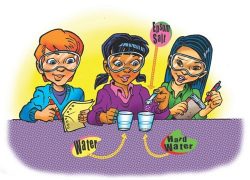
Making the hard water
- To make hard water, place ¼ cup of water in the cup labeled Hard Water and add 2 teaspoons of Epsom salt. Stir the solution until no more solid will dissolve.
Combining the soap solution with water and hard water
- Place ¼ cup of water in the cup labeled Water.
- Add 1 tablespoon of the soap solution to both the Water and Hard Water cups.
- Look at both cups from the top and the side.
Expected results:
The soap solution will mix with water and cause the water to look cloudy. When the soap solution is added to hard water, a white curd-like substance will form. This is the precipitate, “soap scum”.
Ask students:
- What differences, if any, do you observe in the way soap combines with water compared with what happened when it was added to hard water?
The soap solution turned the water cloudy but formed white chunks when mixed with the hard water.
Have a discussion about what test could be done to tell if the soap scum is the same or different than soap.
Ask students if they think the white substance that formed in hard water is solid soap or a new substance. Ask students to propose tests they could carry out on both the “soap scum” precipitate and soap to determine if they are the same substance or different substances. Students might suggest comparing the ability of the two substances to clean something, test the way the two substances feel, test whether they both dissolve in water, or test to see if they can be used to make bubbles.
Since the “bubbling” of the soap solution is easy to observe and test, suggest that students compare the bubbling ability of the soap scum (after it is dissolved in water) to the bubbling ability of soap. Students may suggest adding soap to water and soap scum to water in separate containers and shaking the resulting solutions, or blowing into them to compare the amount of suds (bubbles) that form.
Have students filter the soap scum precipitate.
The following is an example of one way to compare soap and soap scum based on how well they form bubbles or suds when added to water and shaken in a bottle. The procedure begins by collecting the soap scum by filtering it.
Question to investigate: How can you test if soap scum is different from soap?
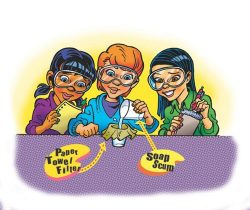
Procedure
Filter the soap scum precipitate
- Place a paper towel on the top of a plastic cup as shown.
- Hold the paper towel filter in place as you pour the liquid and solid soap scum mixture from the Hard Water cup into the filter. Allow the water to drip through the filter. You will use the dried precipitate tomorrow or the next time your class meets.
While you let the water drip through the paper towel, begin setting up for the next part of the experiment.
Prepare the cups for the next day
- Thoroughly wash out and dry the cups you used for the soap and the Epsom salt solutions. You can reuse the cup labeled Soap and re-label the other cup Soap Scum.
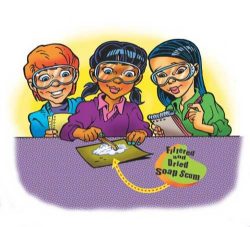
NEXT DAY
Have students collect the dried precipitate.
- Carefully lift the paper towel filter and lay it down as shown. Use a popsicle stick or plastic spoon to scrape the solid from the towel and collect the dried soap scum. Expect about 1/8 to 1/4 teaspoon of precipitate.
Have students add soap and soap scum precipitate to separate water containers to test for bubbling.
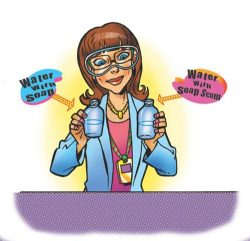
- Add 3 tablespoons of water to the cups labeled Soap and Soap Scum.
- Use a measuring spoon to measure the amount of soap scum you have. Add the soap scum to its labeled cup and stir gently.
- Use a measuring spoon to place a similar amount of soap flakes into the cup labeled Soap and stir gently.
- Carefully pour the solution from each cup into a separate small bottle.
- Put the cap on each bottle and be sure it is fastened tightly. Shake both bottles for a few seconds. Then compare the amount of bubbles observed in the two bottles.
Expected results:
The soap scum may look like soap, but it does not dissolve in water as well as soap does. Also, the soap scum and water mixture does not bubble as much as the soap solution when the bottles are shaken. Students may notice some bubbling in the bottle containing soap scum and water. This may be due to some residual unreacted soap in the solid precipitate; however, the difference in the amount of bubbling in each bottle should be very noticeable and sufficient to conclude that the solid soap scum is different from the original Ivory soap.
Ask students:
- Based on your observations, do you think that soap scum is different from soap? Explain.
Yes. The soap scum did not form as many bubbles as the soap did when they were added to water and shaken. - Do you think adding soap to hard water causes a chemical reaction? Why or why not?
Yes. Adding soap to hard water is a chemical reaction because a new substance—soap scum— was formed.
Explain
Play an animation of magnesium reacting with soap to make soap scum.
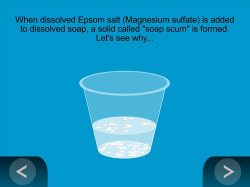
Show the Animation Soap Scum Precipitate
Explain that in fresh water, the soap molecules dissolve and interact and mix throughout the water. But in hard water the magnesium ions from the Epsom salt solution join the soap molecules together to form a new substance, which appears as a white solid known as soap scum. Even though the solid soap scum looks like soap, the precipitate is not soap anymore because it is chemically different. It does not dissolve in water like soap does, and the resulting mixture does not form suds or bubbles like a soap solution does when it is shaken.
Extend
Have students try washing their hands with soap and salt water.
Ask students if they think soap will work as well in salt water as it does in fresh water. Tell students that they can test this by washing their hands with soap using both salt water and fresh water.
Materials for each group
- Ivory soap
- 2 Clear plastic cups
- Water
- Salt
- Plastic spoon
- Waste container
- Paper towels
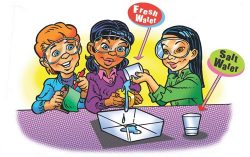
Procedure
- Label one cup Salt Water and the other cup Fresh Water. Place about ½ cup of water into each labeled cup.
- Add about two teaspoons of salt to the water in the Salt Water cup and stir until most or all of the salt dissolves.
- Hold your hands over a waste container and have your partner pour some fresh water into your hands.
- Move a piece of soap in your hands like you would if you were washing your hands.
Expected results:
The water and soap will create some bubbles and lather.
- Use extra water to rinse your hands over the waste container or rinse them at a sink. Dry your hands thoroughly using a paper towel.
- Hold your hands over the waste container again and now have your partner pour some salt water into your hands.
- Move a piece of soap in your hands like you would if you were washing your hands.
Expected results:
The salt water and soap make very few bubbles.
- Use water to rinse your hands off over the waste container or rinse them at a sink.
Explain that salt has a positive sodium ion which attracts water molecules and soap molecules. The sodium ion doesn’t bind two soap molecules together like the magnesium ion but it does interfere with the way water and soap normally interact to make bubbles and lather.
Ask students:
- Do you think you could wash your hands well in the ocean? Why?
No. The salt from the ocean would interfere with the washing ability of soap.
Tell students that there is a special soap called Sailor’s Soap that can be used if you have to wash your hands or clean something in salt water.

